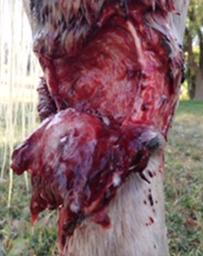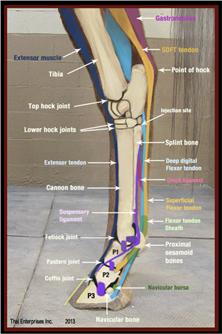An interesting case from Alpine Equine Hospital: Traumatic wounds of the hindlimb
Bonnie, 18-year-old American Quarter Horse, was seen at Alpine Equine Hospital with a hindlimb laceration pictured below over her hock of unknown etiology (suspected kicking the fence). The owners called the office when they found it that morning, and she was trailered into the clinic for further work-up.

On evaluation she was significantly lame on the left hind and there was apparent joint involvement. Otherwise her physical exam was normal, and she was stable. First off, it is important to know the anatomy of the area. Here are some important structures under the skin over the hock (joints, tendons, ligaments).

When we are evaluating a wound, we want to assess which of these structures are affected. The wound had a significant amount of contamination. After assessment, the veterinarians at Alpine Equine began working on a management and treatment plan with the owners, including potential complications. The wound was surgically debrided, and a regional limb perfusion of antibiotics was performed. She was started on pain medications and aggressive antibiotic therapy. She spent three weeks at Alpine Equine Hospital for wound management and daily bandage changes.
Over the course of three weeks, the wound had daily bandage changes and wound irrigation due to a large amount of exudate (discharge) produced each day. As gruesome as it looked that first day, we slowly started seeing improvement in her gait and temperament. The large wound bed started to fill with granulation tissue. Bandage dressings were chosen based on daily evaluations of the wound to promote debridement or granulation tissue formation. She went home after 21 days, with a much improved but still substantial wound.

Bonnie was lucky that she received the care she did with minimal complications and is on the track to recovery. Unfortunately, this is nowhere near close to being healed. She will require continued care with daily medications, daily bandage changes, and frequent veterinary visits for proper assessment and treatment until it fully heals over. Our hope is for her to continue without complications and to completely heal with minimal scar tissue.
